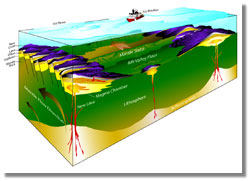 |
 Cheap,
Renewable Hydrogen Cheap,
Renewable Hydrogen
|
 |
 |
Photos of high-throughput reactor showing A) reactor with common headspace top plate (used for catalyst reduction) and B) reactor with isolated headspace plate (used for reaction and gas chromatograph analysis).
Credit: G. W. Huber, J. W. Shabaker, and J. A. Dumesic, University of Wisconsin-Madison; NSF, DOE |
New Catalyst
Paves Way for Cheap, Renewable Hydrogen Scientists
have developed a hydrogen-making catalyst that uses cheaper materials
and yields fewer contaminants than do current processes, while extracting
the element from common renewable plant sources. Further, the new
catalyst lies at the heart of a chemical process the authors say
is a significant advance in producing alternate fuels from domestic
sources. In the June 27 issue of the journal Science, James
Dumesic, John Shabaker and George Huber, of the University of Wisconsin
at Madison, report developing the catalyst from nickel, tin and
aluminum and using it in a process called aqueous-phase reforming
(APR), which converts plant byproducts to hydrogen. The process
performs as well as current methods that use precious metals such
as platinum, yet runs at lower temperatures and is much cleaner.
More... (posted
June 30, 2003)
|
 |
 |
This cross-section of the Gakkel Ridge as compiled by Henry Dick, co-chief scientist on the Arctic Mid-Ocean Ridge Expedition, contains a drawing of the USCGC Healy for scale.
Credit: Paul Oberlander / Woods Hole Oceanographic Institution |
Behavior of Arctic Ocean Ridge Confounds Predictions; May Lead to New Insights into Crust Foundation
The discovery that an ocean ridge under the Arctic ice cap is unexpectedly
volcanically active and contains multiple hydrothermal vents may
cause scientists to modify a decades-long understanding of how ocean
ridges work to produce the Earth's crust. The new results, which
come from a study of the Gakkel Ridge, one of the slowest spreading
ridges on Earth, have broad implications for the understanding of
the globe-encircling mid-ocean ridge system where melting of the
underlying mantle creates the ocean floor. In two articles appearing
in the June 26 edition of the journal Nature, scientists
supported by the National Science Foundation and Deutsche Forschungsgemeinschaft
present striking new results obtained during a nine-week research
cruise that lasted from August to October of 2001.
More... (posted
June 30, 2003)
|
 |
|
 |
Efforts to boost populations of endangered
species, such as the giant panda and the black-footed ferret,
above, may benefit from the isolation of a protein that in domestic
ferrets helps establish pregnancies. The protein, glucose-6-phosphate
isomerase, also plays roles in cellular metabolism and in the
spreading of tumors.
Credit: U.S. Fish and Wildlife Service |
For Ferrets, GPI Means 'Get Pregnancy Initiated'
Knowing what makes a ferret pregnancy take hold could help biologists
save endangered species or understand how tumors spread. Specifically,
biologists examining early pregnancy in domestic ferrets report
they have identified a protein necessary for embryos to implant
successfully in the wall of the uterus, which is pregnancy's first
step in mammals. Newly discovered as a molecular signal in ferret
pregnancies, the protein -- glucose-6-phosphate isomerase (GPI)
-- has long been known for its wide-ranging role in metabolism,
where it breaks down sugars in organisms as diverse as bacteria
and humans. Researchers Laura Clamon Schulz and Janice M. Bahr at
the University of Illinois at Urbana-Champaign report their results
in the Proceedings of the National Academy of Sciences. According
to Bahr, "The identification of GPI as a key signal secreted from
mother to embryo in the ferret is an important step forward in the
understanding of pregnancy in this and related species."
More... (posted June 30, 2003)
|
 |
|
Draft FY2003-2008 GPRA Strategic Plan Available
The National Science Foundation solicits your
comments on its draft strategic plan. The Government Performance and
Results Act of 1993 – what we call GPRA - requires all federal agencies
to update their strategic plans every three years. NSF submitted its current
strategic plan for FY 2001- 2006 in October 2000. Therefore we will submit an
updated strategic plan to the Administration and the Congress by September 2003.
(posted June 9, 2003)
|
 |
|
NSB Seeks Comments on Draft Report on National Workforce
Policies for Science and Engineering
(posted
June 6, 2003)
|
 |
| |


|

